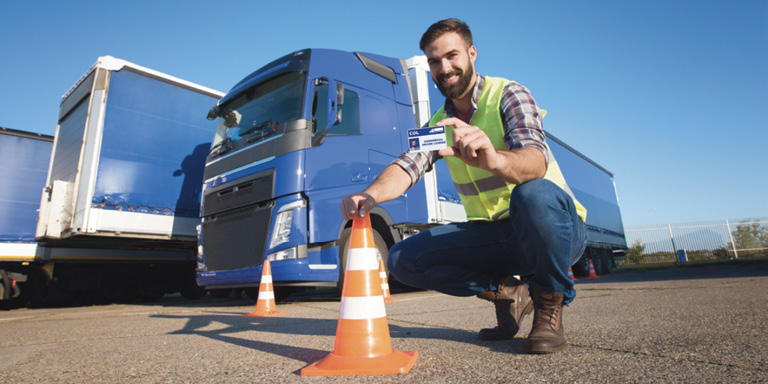CDL Testing Gets a Refresh
New technology safety features on commercial vehicles have prompted upgrades to the CDL testing model
Technology has altered the commercial driving landscape. A 2020 study by the Insurance Institute for Highway Safety (IIHS) finds that trucks equipped with forward collision warning systems had 22% fewer crashes and those with automatic emergency braking systems lowered crashes by 12%.
As more commercial vehicles were equipped with these safety technologies, it became more challenging for examiners to use the existing CDL testing model to evaluate drivers’ skills. Further, examiners lacked the resources and training to test drivers of newer vehicles. It was clear that the CDL testing model needed a makeover.
A data-driven process
To address these issues, AAMVA launched the CDL Testing System Modernization Initiative in 2016 to explore updating the testing system for entry-level commercial drivers. AAMVA’s Test Maintenance Subcommittee (TMS) and International Driver Examination Certification (IDEC) Board headed up the data-driven initiative. They began by evaluating years of data related to collisions, traffic citations and out-of-service orders to help better understand what was happening on the roads. The analysis phase took two years.
The committees then reviewed test items for pre-trip inspections, which numbered over 100. Additional components needed to be tested, but would have raised that total to 120, says Jeffrey Oberdank, administrator for New Hampshire’s Driver Licensing Bureau and the TMS chair. A pre-inspection checklist is now included in the exam to reflect what drivers typically experience on the job.
Drivers will be allowed to use a memory aid, which is scripted in the same way for everyone, says Steven Ayers with the Virginia Department of Motor Vehicles and a member of the Test Maintenance Subcommittee who also assists with AAMVA’s train-the-trainer classes. However, “the memory aid only helps drivers understand what they need to check during an inspection, not how to check them,” adds Ayers.
“The more we discussed the need to add other skills to the test, the more we realized it would become a test of memorization rather than the driver’s knowledge,” Oberdank says. “There is no way anyone could pass a test with 120 items, which goes beyond entry-level skills testing. We boiled it down to the most essential items to determine whether the vehicle is safe to drive.”
The result is a more safety-focused test of the pre-inspection process. For example, the 2005 version of the test required drivers to inspect all 18 wheels of an 18-wheeler, while the new model requires drivers to check one wheel to show they know how to inspect it. The understanding is that trucking companies will require drivers to inspect all 18 wheels before they hit the road, he adds.
What’s new on the test?
Some examiners expressed concerns about the large footprint of the previous test version. Some sites simply don’t have the space to accommodate the inspection, says Cynthia Delp, a driver licensing hearing officer for the Iowa Department of Transportation, who serves as vice-chair of IDEC. However, the new model requires less space for the inspection phase. “With the new testing model, sites only need 280×40 feet of space compared to 240×130 feet in a carousel-like layout,” Delp says.
In addition to testing a driver’s knowledge of safety features, the new model updates the basic control skills test, such as how to complete a forward stop to avoid front-end collisions, which occur frequently among commercial drivers, says Jimmy Gonzales, manager of commercial driving services for Maryland Department of Transportation. “The forward stop is important to make sure drivers can see vehicles in front of them to avoid collisions,” he says.
“It’s not about making the test easier or faster, but about making it adaptable to technology changes in the future,” Ayers says.
Field tests
Once the new model test was created, it was time to try it out. The COVID-19 pandemic added some hurdles to choosing which states would participate in the field tests. The first field tests began in July 2021 in New Hampshire, followed by Maryland and Virginia. To ensure objectivity and transparency, the field tests were monitored by the Traffic Injury Research Foundation, an independent road safety research institute.
New Hampshire was selected for the pilot program because of its certified train-the-trainer program. As a state examiner state, examiners were prepared to do the testing. It’s also Oberdank’s home state, so he was able to bring ideas from the committees to state examiners and get feedback on how they might work in the field.
Maryland is a hybrid state with both state examiners and third-party testers. Gonzales says examiners in his state found the system easy to understand and administer once they understood the new testing process.
If there are any potential challenges, it may be how some drivers adapt to the test changes. Despite that, Gonzales believes most drivers will perform well on the exam. “Wherever they’re trained and no matter where they operate, prepared and safe drivers should be able to go to any state location and pass the test,” Gonzales says.
Likewise, Ayers believes the field tests in his state of Virginia went smoothly and he is confident that the results will show the model’s effectiveness. Both Ayers and Gonzales feel the new model addresses all the issues they set out to resolve and will be adaptable far into the future.
Looking ahead
Delp believes examiners will experience few issues transitioning to the new testing model because they’re used to learning new processes and technologies on the job. “They won’t need to learn a whole new testing skill set. Instead, they will need only to modify existing test practices. Like everyone else, they want a test that is valid, reliable and promotes measurable highway safety,” Delp says.
Once reviewed and approved by TMS and IDEC, the field test results will be provided to the Federal Motor Carrier Safety Administration (FMCSA), which regulates the CDL program. Once approved by FMCSA, additional training materials will be developed for examiners for a full rollout to all jurisdictions this summer.
Oberdank feels confident the results will meet FMCSA’s requirements with few, if any, further changes or field tests needed. “Because we looked at various data and research before creating the final model, I feel safe in saying that the testing system is doing what we hoped it would.”
As more technologies are introduced, the updated CDL testing model ensures that entry-level commercial drivers have the knowledge and skills to practice safe driving on the roads.
Hear more about CDL Test Modernization from Jeff Oberdank in this episode of our podcast: tinyurl.com/AAMVACast62.




